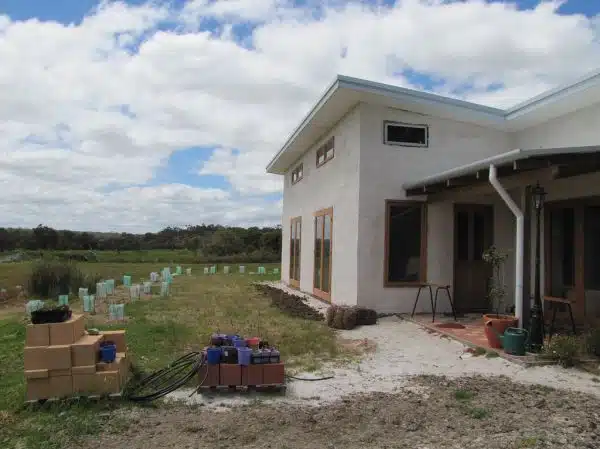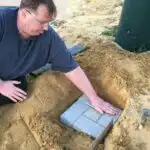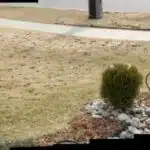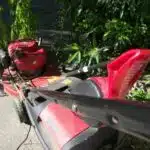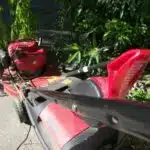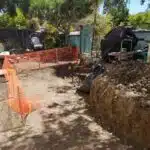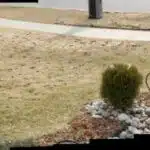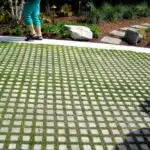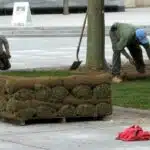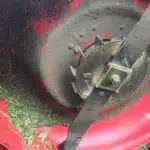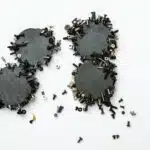Lawn edging pavers are an essential addition to any garden, as they provide a neat and tidy look to the landscape. A mowing strip is a narrow section of lawn that separates the grass from flower beds or other areas in the garden. Installing lawn edging pavers to create a mowing strip can be an easy task if you follow the right steps.
As a landscape designer, I have seen many homeowners struggle with creating a well-defined mowing strip in their gardens. Poorly defined edges not only make it difficult to maintain the lawn but also decrease the curb appeal of your home. In this article, I will guide you through the process of installing lawn edging pavers to make a mowing strip that will enhance your garden’s beauty and functionality. Whether you are new to gardening or an experienced landscaper, you will find this article helpful in achieving your goals of creating an attractive and practical outdoor space.
Assessing Your Garden’s Needs
To create a stunning outdoor space, it is crucial to assess your garden’s layout and plan accordingly. A well-designed garden should be functional and aesthetically pleasing. This can be achieved by incorporating various elements such as lawn edging pavers that help define the boundaries between different areas of the garden.
Before selecting plants for your garden, consider your garden layout. Take note of the shape and size of your garden, as well as its orientation to the sun. Think about how you want to use your outdoor space – will it be a place for entertaining guests or a private sanctuary for relaxation? Once you have considered these factors, choose plants that are appropriate for the area. For instance, if you have a shady spot, select plants that thrive in low light conditions.
Choosing the right lawn edging pavers is also essential in creating an appealing outdoor space. There are various types of pavers available in the market today, each with its unique features and benefits. Consider which type would best suit your needs based on factors such as durability, longevity, style, and cost.
Transitioning into choosing the right lawn edging pavers involves considering factors such as durability and longevity. By selecting high-quality materials that are built to last, you can ensure that your lawn edging pavers will maintain their integrity over time while adding value to your property. In addition to durability and longevity, other key factors to consider when choosing lawn edging pavers include style and cost-effectiveness.
Choosing The Right Lawn Edging Pavers
After assessing your garden’s needs, the next step in creating a mowing strip is to choose the right lawn edging pavers. Lawn edging pavers provide a clear boundary between the lawn and planted areas, making it easier to maintain a neatly trimmed appearance. There are many benefits to using lawn edging pavers, including their ability to prevent grass from growing into flower beds and other landscaped areas. However, there are also drawbacks to consider, such as the cost of materials and installation.
When choosing lawn edging pavers for your mowing strip, there are several design and style options to consider. Some popular choices include brick, concrete, and stone pavers. Each material has its own unique characteristics that can enhance the look of your garden. For example, brick pavers offer a classic look that complements traditional landscaping styles, while stone pavers provide a more natural appearance that can work well in rustic or modern designs.
To ensure that you choose the right lawn edging pavers for your mowing strip project, it’s important to measure the area where you’ll be installing them. This will help you determine how many pavers you need and what size they should be. When measuring your garden, be sure to take into account any curves or angles in the layout of your lawn. By taking accurate measurements upfront, you can save time and money by avoiding costly mistakes during installation.
Next section topic: Measuring the Area for Your Mowing Strip
Measuring The Area For Your Mowing Strip
To create a mowing strip using lawn edging pavers, the first step is to measure the area where you want to install them. Accurate measurements are crucial for calculating materials and determining the number of pavers needed. Begin by measuring the length and width of your lawn, then multiply these two numbers together to find the total square footage.
Once you have determined the square footage of your lawn, you will need to adjust for any curves or irregularities in the border. If your lawn has curved edges, add an additional 10% to your total square footage to account for any extra pavers needed. It’s always better to have more than enough pavers than not enough, so rounding up is always a good idea.
After you have calculated the amount of materials needed and adjusted for curves or irregularities, it’s time to move on to marking the borders of your mowing strip. This is an essential step in creating a clean and professional-looking edge that will keep grass from creeping into flower beds or walkways. In the next section, we’ll cover how to mark out your mowing strip with string and stakes, ensuring that everything is level and straight before you start installing your edging pavers.
Marking The Borders Of Your Mowing Strip
After measuring the area for your mowing strip and marking its borders, it’s time to start installing lawn edging pavers. This step is crucial in creating a clean and defined look for your landscape. Not only will it make mowing easier, but it will also add an aesthetic touch to your lawn.
To start, using stakes and string, create a straight line for your mowing strip. This will ensure that your edging pavers are installed in a straight line with consistent width. Once you have created the line, you can then begin laying out your pavers along the border of the strip. Be sure to take note of any curves or turns in your design as this may require additional cutting of the pavers.
Incorporating decorative elements into your edging design can also elevate the look of your landscape. Consider using different colored pavers or incorporating patterns into the design. With careful planning and attention to detail, you can create a beautiful and functional mowing strip that adds value to your property.
Moving forward, digging the trench for your edging pavers is the next important step in this process. By following these steps carefully, you will be able to create a professional-looking mowing strip that enhances the overall beauty of your landscape design.
Digging The Trench For Your Edging Pavers
Before installing edging pavers, it is important to measure the area to ensure that the edging pavers fit properly. Once the area is measured, a trench must then be dug to the desired depth. To ensure that the pavers are properly aligned and secure, the trench should be dug in a straight line with the edges lined up with the edges of the area. Finally, the edging pavers can be placed in the trench and secured in place.
Measuring The Area
Accurately measuring the area where you plan to install your lawn edging pavers is crucial in achieving a professional-looking result. As a landscape designer, I recommend using a tape measure to ensure precision. Make sure that you measure both the length and width of the area, and take note of any curves or bends that may affect your layout.
Adjusting for curves can be a bit tricky but is essential in creating an even and smooth mowing strip. To accurately adjust for curves, use a flexible hose or string to map out the shape of your desired edge. Once you have laid out the curve, use a series of stakes to mark the area where you will need to dig. Keep in mind that if you are using pre-made edging pavers, there may be some restrictions on how tight or sharp of curves they can accommodate.
In conclusion, taking accurate measurements and adjusting for curves are two crucial steps in getting your lawn edging pavers installed correctly. By paying attention to these details, you will ensure that your mowing strip looks professionally done and functions as intended.
Digging The Trench
Now that you have accurately measured your lawn and adjusted for curves, the next step in installing your edging pavers is to dig the trench. This process requires a few tools and techniques to ensure that your mowing strip remains level and sturdy over time.
Tools required for digging the trench include a spade or shovel, a string line, stakes, and a spirit level. Before starting, mark out the area where you will be digging using the string line and stakes. This will help you maintain a straight and consistent depth throughout the length of your mowing strip. Using a spirit level can also help you ensure that the trench is level from start to finish.
The best digging technique involves removing soil in small increments rather than trying to dig too much at once. Start by digging a shallow trench along your string line, then gradually deepen it until it reaches the desired depth for your pavers. Be sure to remove any rocks or debris as you go, as these can cause bumps or unevenness in your mowing strip. With these tips in mind, you’ll be well on your way to creating an attractive and functional lawn edging with professional-looking results.
Aligning The Edging Pavers
After successfully digging the trench for your edging pavers, the next step is to align them properly. Aligning the pavers can be a tricky task, but it’s essential to ensure that your mowing strip looks neat and tidy. One of the first things to consider when aligning your pavers is the pattern you want to achieve. You may opt for a simple straight line or a more intricate design, depending on your preference.
When aligning your pavers, pay close attention to spacing. Pavers that are too far apart will leave gaps that can collect dirt and debris, while those that are too close together will make it difficult for grass to grow between them. A general rule of thumb is to leave a gap of about 2-3 inches between each paver, although this can vary depending on the size of your edging and the look you’re trying to achieve.
To ensure that your edging remains level, we recommend using a spirit level during installation. This tool will help you identify any areas where the pavers are uneven and adjust them accordingly. As you lay each paver down, check its alignment with adjacent ones before moving on to the next one. Taking these steps will ensure that your edging looks professional and lasts for years to come.
Adding A Layer Of Sand
To ensure the longevity of your mowing strip, it is essential to add a layer of sand before laying down the edging pavers. Using a tamper, compacting the soil in the area where you want to install the strip is necessary to create a stable base for the sand. Afterward, spread and level sand evenly across the area using a rake.
Using a tamper helps to compact soil particles, which reduces air pockets that can cause settling or shifting of your edging pavers over time. It also ensures that your mowing strip remains level and uniform throughout its lifespan. Once you have packed down the soil, use a rake to remove any debris or large stones that could interfere with proper leveling of your sand layer.
Leveling sand is an important step in creating a stable base for your edging pavers. Spread it evenly across the area and use a long board or screed to smooth out any lumps or bumps in the surface. The resulting flat surface will provide an even layer for your edging pavers installation, ensuring they sit uniformly without wobbling or tilting. With this foundation in place, you are now ready to lay your edging pavers and create an attractive and functional mowing strip that will last for years to come.
Laying Your Edging Pavers
- When choosing the right edging pavers for a mowing strip, it is important to take into account the amount of foot traffic in the area, the type of soil and material for the road, as well as the desired aesthetic of the finished product.
- In order to ensure a successful installation, it is important to prepare the ground properly by removing any existing vegetation and leveling the surface.
- Once the ground has been properly prepared, the edging pavers must be laid in a straight line, ensuring that the edges of the pavers line up with each other.
- The pavers should then be firmly pressed into the ground, tamped down and filled with a layer of sand for stability.
- Once the pavers are laid, any gaps between them should be filled with soil and tamped down to ensure a level surface.
- Finally, the edging pavers should be sealed with a sealant to protect them against the elements and to prolong their lifespan.
Choosing The Right Pavers
When it comes to lawn edging pavers, choosing the right type of paver finish can make all the difference in achieving your desired aesthetic. There are various finishes available on the market today, each with its own unique texture and look. Some popular options include natural stone, concrete, and brick. Natural stone pavers offer a rugged, earthy feel that is perfect for rustic garden designs while concrete pavers provide a sleeker, more modern look that works well in contemporary gardens. Brick pavers, on the other hand, offer a classic touch that is timeless and elegant.
In addition to selecting the right type of finish for your edging pavers, you should also consider the color options available. Different colors can have a significant impact on the overall aesthetics of your garden design. For instance, light-colored pavers can help create an illusion of space and openness while darker hues can add depth and drama to your landscape. You should also consider how the color of your edging pavers will complement or contrast with other elements in your garden such as plants or outdoor furniture.
Ultimately, when choosing edging pavers for your lawn mowing strip project, it is essential to select those that best fit in with your overall garden design concept. Whether you prefer natural stone or concrete finishes or bright-colored or subtle hues – there are endless possibilities to choose from. By taking time to consider these factors carefully before making any purchase decisions, you can ensure that you achieve a beautiful and functional lawn mowing strip that will enhance your outdoor living space for years to come!
Preparing The Ground
Choosing the right edging pavers for your lawn mowing strip is only one part of the process. Preparing the ground before laying your pavers is critical to ensuring a sturdy and long-lasting installation. Before you begin, it’s essential to clear the area of any debris, rocks, or weeds that could interfere with the paving process. You should also consider using a weed barrier to prevent future weed growth.
After clearing the area, you’ll need to level the ground by removing any high spots and filling in any low areas. This step is crucial because uneven ground can cause your edging pavers to shift over time. Once you’ve leveled the ground, it’s time to install a compacted base layer of gravel or crushed stone. This layer will provide a stable foundation for your edging pavers and help prevent settling or shifting.
Avoiding common mistakes during this preparation process can save you time and money in the long run. For example, failing to remove all debris or not properly leveling the ground can lead to uneven paving and costly repairs down the road. By taking these necessary steps before laying your edging pavers, you can ensure a successful installation that will enhance your garden design for years to come.
Installing The Pavers
After preparing the ground, the next step in laying your edging pavers is installing them. This process involves placing each paver carefully and securely to ensure a level surface that will withstand regular use. Before installing your pavers, it’s important to consider the color and texture you want for your lawn mowing strip. Choosing a color that complements your garden design can enhance the overall aesthetic of your outdoor space.
When installing the pavers, it’s essential to ensure their durability by using a sturdy adhesive or sand to hold them in place. This will prevent shifting or movement over time, which can lead to an uneven surface and potential safety hazards. It’s also crucial to maintain proper spacing between each paver to allow for expansion and contraction due to temperature changes.
After laying all of your edging pavers, it’s important to inspect the area thoroughly and make any necessary adjustments before finishing the installation process. This includes checking for any uneven spots or gaps between pavers that could cause tripping hazards or damage over time. By following these steps and taking care during the installation process, you can create a beautiful and functional lawn mowing strip that enhances both the appearance and safety of your outdoor space.
Ensuring Proper Alignment And Leveling
Now that you have laid your edging pavers, it’s time to ensure stability and proper maintenance of your lawn edging. One important step is to ensure that the pavers are properly aligned and leveled. This will not only make your mowing strip look neat and clean, but also prevent tripping hazards and minimize erosion.
To ensure proper alignment, use a string line to guide the placement of each paver. A level can also be used to ensure that the pavers are level with each other. If necessary, adjust the height of individual pavers by adding or removing sand or soil beneath them. Once all the pavers are in place, use a rubber mallet to gently tap them into place and set them firmly in the ground.
Proper maintenance is crucial for ensuring the longevity of your lawn edging. Regularly inspect the edging for any cracks or damage, as well as any signs of movement or shifting. Fill any gaps between pavers with sand to prevent weeds from growing through and maintain a neat appearance. Additionally, avoid using heavy machinery near the edging as this can cause damage. With proper alignment and maintenance, your lawn edging will provide an attractive and functional border for years to come.
As you complete the installation process for your lawn edging pavers, you might encounter spaces that require smaller pieces of pavers to fit in perfectly. Cutting these pavers can be done using a chisel or saw blade specifically designed for cutting stone or concrete materials. Be sure to wear protective gear when cutting the pavers and follow manufacturer instructions carefully. With these handy tips on cutting pavers to fit your space, you’ll have a perfect mowing strip in no time!
Cutting Pavers To Fit Your Space
As a landscape designer, I always recommend using lawn edging pavers to create a mowing strip. However, cutting the pavers to fit your space is necessary for achieving a perfect finish. Before you start cutting, it’s important to choose the right tools and take proper safety precautions.
Choosing the right tools is crucial for this task. You will need a masonry saw or angle grinder equipped with a diamond blade. A masonry saw is ideal for large-scale projects, while an angle grinder works best for smaller cuts or curves. Both tools can be rented from your local hardware store if you don’t already own them.
Proper safety precautions are essential when using power tools. Always wear eye and ear protection, as well as gloves and a dust mask to protect yourself from debris and dust particles. Additionally, make sure your work area is well-ventilated since cutting pavers produces a lot of dust.
Transition: Now that you have chosen the right tools and taken proper safety precautions, it’s time to move on to filling the gaps with sand.
Filling The Gaps With Sand
Now that the lawn edging pavers are in place, it’s time to fill in the gaps with sand. Using polymeric sand is highly recommended for this step as it has a binding agent that helps keep everything together. The process starts by pouring the sand over the pavers and sweeping it into the gaps using a broom.
One of the benefits of using polymeric sand is that it prevents weeds from growing between the pavers. This is because the sand creates a barrier that makes it difficult for weed seeds to germinate. Additionally, polymeric sand hardens when exposed to moisture, making it more resistant to erosion caused by heavy rain or water runoff.
After filling in all the gaps with polymeric sand, use a leaf blower or soft-bristled brush to remove any excess sand from the surface of your mowing strip. This will give your lawn edging pavers a clean and polished look. Now that you have completed this step, you can move on to adding topsoil to your mowing strip.
Adding Topsoil To Your Mowing Strip
Topsoil preparation is a crucial step in creating a mowing strip for your lawn. It ensures that the soil around the pavers is level with the rest of your lawn and allows for proper drainage. Before adding topsoil, remove any grass or weeds that may be growing in the area. This will ensure that the new soil is not competing with existing plants for nutrients.
Once you have cleared the area, consider adding soil amendments to improve soil quality. Common options include compost, manure, and peat moss. These amendments can improve soil drainage and fertility, which will help your lawn grow healthier and stronger over time. Be sure to mix them thoroughly into the existing soil before adding topsoil.
When adding topsoil, aim for a depth of at least 2 inches. Spread it evenly over the prepared area and use a rake to smooth out any bumps or uneven spots. Afterward, water the area thoroughly to settle the soil and provide moisture that will aid in plant growth. With proper topsoil preparation and amendment options, you can create a mowing strip that not only looks great but also supports healthy lawn growth.
With your mowing strip’s topsoil ready to go, it’s time to prepare for lawn maintenance by setting up an irrigation system or determining how you’ll water your lawn regularly. A well-maintained lawn requires regular watering to stay healthy and lush throughout the year. In addition, consider investing in fertilizers or other plant treatments that will keep your grass looking its best while minimizing damage from pests or diseases. With these preparations in place, you’ll be able to enjoy a beautiful lawn year-round without worrying about extensive upkeep or costly repairs down the line.
Preparing For Lawn Maintenance
As a landscape designer, I understand the importance of garden maintenance and lawn care tips to ensure a healthy and beautiful outdoor space. Proper preparation for lawn maintenance is essential, especially when it comes to trimming around edging pavers. Before installing your mowing strip, consider the type of grass you have and its growth habits.
One important tip for maintaining your lawn is to not cut more than one-third of the grass blade at a time. This allows the grass to recover quickly and promotes healthy growth. When trimming around edging pavers, it’s best to use a string trimmer or hand-held shears to avoid damaging the pavers. Additionally, make sure to clean up any debris after trimming to prevent it from getting caught in the mower and causing damage.
Proper maintenance of your lawn edging pavers will not only keep them looking great but also extend their lifespan. Regularly inspect them for any signs of damage or movement and make necessary repairs. Keep the area around the pavers free from weeds and debris to prevent them from causing any damage. By following these simple lawn care tips, you can enjoy a beautiful and well-maintained outdoor space for years to come.
Maintaining Your Lawn Edging Pavers
After preparing your lawn for maintenance, it’s time to install the lawn edging pavers to create a clean mowing strip. To begin, dig a trench along the perimeter of your lawn where you want the pavers to be installed. Ensure that the trench is wide enough to accommodate the width of the pavers and deep enough so that they sit flush with the ground. Once you have dug out the trench, lay down a layer of sand or gravel at the bottom to provide a stable base for your pavers.
Next, start placing your pavers in the trench, making sure they are level and spaced evenly apart. Once all of your pavers are in place, fill in any gaps between them with sand or gravel. To prevent weed growth between your pavers, apply a sealant on top of them after allowing them to settle for a few days. This will also help protect your pavers from damage caused by water and weathering.
Sealing pavers is an important step that shouldn’t be skipped as it will save you time and money in the long run. However, if weeds do begin to grow around or through your edging pavers despite sealing them, there are solutions available such as using weed killer or pulling them out manually. Troubleshooting common issues like this can help ensure that your lawn remains neat and tidy while also protecting your investment in lawn edging pavers.
Troubleshooting Common Issues
A well-designed garden is not only aesthetically pleasing but also functional. Installing lawn edging pavers to create a mowing strip is one way to achieve both of these goals. However, there are common issues that may arise during the installation process that can affect the overall outcome of your project.
Fixing mistakes can be time-consuming and costly, especially when it comes to landscaping projects. One common mistake is not properly preparing the soil before installing the pavers. This can cause unevenness in the surface, leading to potential tripping hazards or an unsightly appearance. To prevent this from happening, make sure to remove any weeds or grass and level the area before laying down a base layer of compacted gravel.
Preventative measures are key to avoiding problems during the installation process. For instance, not measuring accurately can result in having too few or too many pavers, which can affect the width and continuity of your mowing strip. Taking measurements twice and using a string line as a guide can help ensure accuracy. Additionally, using a rubber mallet to secure each paver in place will prevent shifting over time.
Enjoying your beautiful, functional garden requires attention to detail and proper maintenance. By following these preventative measures and fixing mistakes as they arise, you can create a stunning mowing strip that adds value to your home while increasing its curb appeal. Remember that every step you take towards creating a beautiful landscape is worth it in the end!
Enjoying Your Beautiful, Functional Garden!
After troubleshooting common issues, it’s time to enjoy your beautiful and functional garden! One way to enhance the look of your lawn is by installing lawn edging pavers. These pavers not only add an aesthetic appeal but also serve as a mowing strip, making maintenance easier.
The benefits of gardening extend beyond the beauty it adds to our surroundings. Gardening can be therapeutic and reduces stress levels. It also promotes physical activity, which is essential for our overall health. Moreover, growing one’s fruits and vegetables can save money on groceries while providing fresh produce that is free from harmful chemicals.
To ensure your garden remains healthy and beautiful, regular maintenance is crucial. Deadheading flowers, removing weeds, and watering plants are some essential tasks that should be done regularly. Also, practicing sustainable gardening practices such as composting and using natural pesticides can help reduce waste and promote a healthier environment.
Remember, gardening is a continuous process that requires patience and dedication. By incorporating these tips for garden maintenance into your routine and enjoying the benefits of gardening, you’re sure to have a thriving garden all year round!
Conclusion
When it comes to creating a beautiful and functional garden, installing lawn edging pavers can make all the difference. By creating a mowing strip, you can easily maintain your lawn while also adding a decorative element to your outdoor space.
Choosing the right lawn edging pavers is essential to ensure longevity and ease of maintenance. When selecting materials, consider factors such as durability, color, texture, and size. It’s also important to measure the area carefully and mark the borders of your mowing strip before digging the trench for your edging pavers.
According to a recent survey by the National Association of Landscape Professionals, 88% of Americans believe that having a well-maintained yard is important. Installing lawn edging pavers is just one way to achieve this goal and create a beautiful outdoor space that you can enjoy year-round. With proper preparation and maintenance, your mowing strip will not only enhance the look of your garden but also make lawn care easier and more efficient.
As a landscape designer, I recommend taking the time to assess your garden’s needs and choosing high-quality materials that will stand up to the elements over time. With attention to detail and regular maintenance, your lawn edging pavers will provide years of beauty and function for you and your family to enjoy. So why wait? Start planning your mowing strip today!
Image Credits
- “Landscaping in Progress – Strawbale House Build in Redmond Western Australia” by Red Moon Sanctuary (featured)

